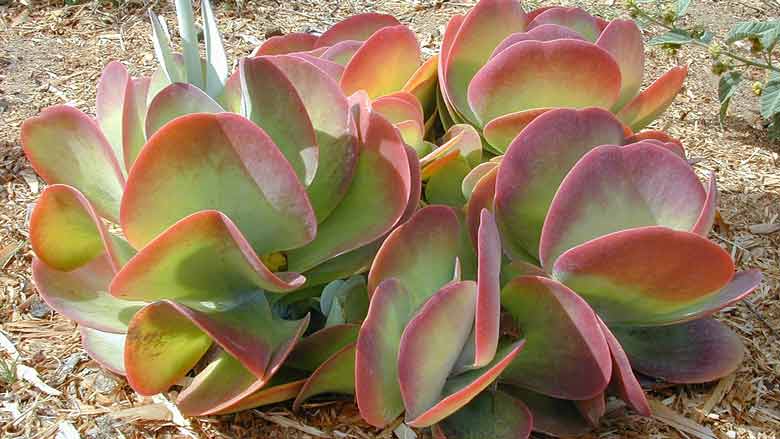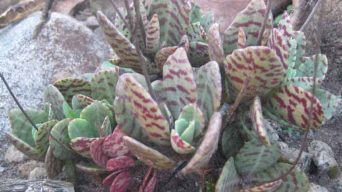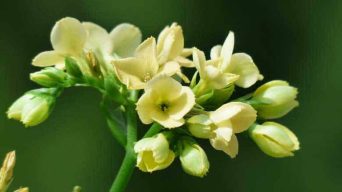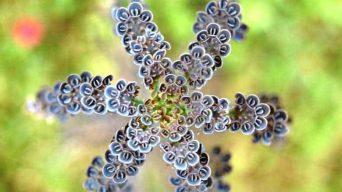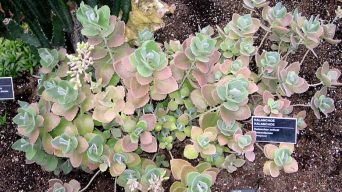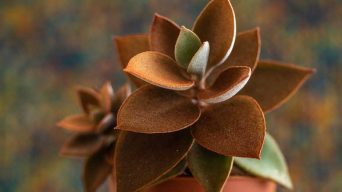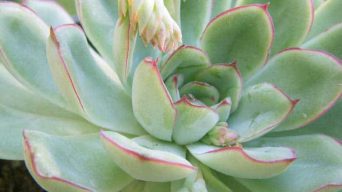The Kalanchoe thyrsiflora succulent plant is a beautiful flowering succulent native to South Africa.
Many people are attracted to this plant because it requires so little care and can be propagated easily.
In this article, you will learn how to take care of Kalanchoe thyrsiflora, what the best conditions for propagation are, and more!
To start, let’s talk about the Kalanchoe thyrsiflora plant itself!
Overview
The Kalanchoe thyrsiflora is a succulent member of the genus Kalanchoe and Crassulaceae family.
Commonly confused with the Kalanchoe luciae, this succulent species from South Africa is traditionally found in dry, rocky areas.
The plant forms rosettes with rounded, fleshy leaves that grow to about 6 in (15 cm) long. The leaves are grayish-green with red margins.
The Kalanchoe thyrsiflora is a flowering succulent with a tall flower stalk, bearing yellow flowers with red-rimmed leaves that die back after blooming.
Kalanchoe thyrsiflora is also known as:
- Paddle Plant
- Flapjack Plant
- Desert Cabbage
How To Care for Kalanchoe Thyrsiflora (Paddle Plant)
Kalanchoe thyrsiflora care is relatively easy and perfect for a succulent beginner.
You just need to follow a few basic but essential Paddle plant care rules.
Sun Exposure & Light Requirements
The Kalanchoe thyrsiflora is a succulent plant that requires full sun to grow and flourish.
They do not like any direct light, especially in the hottest hours of the day when they can burn easily.
However, if you live in an area with cool summers, then partial shade or morning sun can be tolerated for short periods without burning the leaves too severely.
The level of sunlight can change the coloration of the Kalanchoes, which makes them more attractive to look at indoors or when grown outdoors.
When grown indoors, Kalanchoes are great plants to place in a south-facing window or near an east or west-facing window.
They should not be placed in any shaded area that does not have sun for at least six hours per day because this will cause Kalanchoes to grow leggy and thin with no leaves.
Watering Requirements
The Paddle plant is a succulent, so it thrives in arid and dry environments.
The Kalanchoe plant requires little to no water, as the soil should be allowed to dry out between watering cycles.
If you notice that your Kalanchoes are wilting or drooping, this is a sign that they need more water.
An excellent way to tell if your Kalanchoes require less watering is by feeling the soil; if it is dry, you should water them.
Kalanchoe thyrsiflora plants are sensitive to overwatering and will rot quickly in moist environments.
The Flapjack Kalanchoe should be watered in the morning when the plant will have time to dry out before evening falls.
Soil Requirements
Kalanchoe thyrsiflora needs a soil that is well-drained but still retains some moisture.
Be sure to avoid planting Kalanchoes in an area where the water will pool and not drain properly or too fast, which may cause them to collapse from lack of support.
The best potting mix to use is one that consists of equal parts potting soil, sand, and perlite.
Other suitable options include a cactus potting mix or an African violet mix.
Temperature and Humidity
Temperature and humidity requirements for Kalanchoe thyrsiflora are the same as most succulents.
This means that Kalanchoes require bright but not direct sunlight exposure with temperatures between 60°F to 75°F (16°C-24 °C) during the day and 55-65% relative humidity at night.
Fertilizing
Fertilizing Kalanchoe thyrsiflora plants is recommended every few months. This will help the plant stay healthy and maintain a green coloration in its leaves.
It would be best to fertilize Kalanchoe plants with a diluted liquid fertilizer at half the recommended strength.
Fertilize Kalanchoes before winter and after they’ve gone dormant in fall, but not during their active vegetative period.
In summer (when the plant is most actively growing), Kalanchoes must be fertilized every two weeks.
Otherwise, it’s best to supplement only once or twice throughout an entire season.
Kalanchoes are sensitive to high levels of nitrogen, so avoid using urea as a fertilizer. Always dilute any soluble form of fertilizer by mixing one part into four parts water first and then apply it directly onto your Paddle plant.
The Flapjack succulent should have a balanced diet to ensure that it maintains the best possible health and coloration.
Potting and Repotting
The Kalanchoe thyrsiflora is a succulent that does not need to be repotted often.
If it starts out small enough, you may get away with just repotting every two years.
If the plant has already developed a large root system, then once every three or four years.
When potting your Kalanchoe thyrsiflora for the first time, it’s best to use a bigger container than the current one.
This allows for future growth without having to repot too soon.
In fact, Kalanchoe plants are known as ‘living pots’ because they can grow in any size pot and still remain healthy.
Pruning
Pruning Kalanchoe thyrsiflora is needed to keep the plant healthy.
The best time for pruning Kalanchoe thyrsiflora is April or May, when they are starting to grow again and before new leaves emerge during the year.
Prune Kalanchoes by cutting off any dead, diseased, damaged, or crowded leaves with a sterilized blade.
In the first few months after planting, Kalanchoe plants need to be pruned every two weeks.
As Kalanchoes mature and become more established, they can be pruned once a year during late spring or early summer before new leaves emerge.
Pests and Diseases
Kalanchoe thyrsiflora plants are not susceptible to many pests or diseases.
They have few pests and diseases but should still be protected from them with an organic insecticidal soap spray for general pest prevention and treating any infected areas quickly before they spread outwards.
Organic insecticidal soap spray is recommended for Kalanchoe thyrsiflora plants.
It does not damage the Kalachoe’s leaves and stems like other pesticides do but also kills many types of pests. All without harming humans or beneficial insects in your garden.
Pests
Pests that the Kalanchoe thyrsiflora (Paddle plant) is susceptible to are the following:
Spider Mites
Spider mites feed on kalanchoes by sucking sap from their leaves which can cause them to turn brown or yellow, eventually becoming dry and wrinkled as they die off.
These pests are small (about ½ millimeters), so it may be hard to see them without a magnifying glass.
Whiteflies
Whiteflies also suck Kalanchoe’s juices but do not destroy them like spider mites because they have soft bodies.
They lay eggs near the underside of the Paddle plant leaves and hatch into white larvae with light-colored stripes along their sides when ready to pupate.
Mealybugs
Mealybugs are also seen sucking Kalanchoe’s juices, but they do not destroy them as spider mites and whiteflies will.
These bugs can be difficult to see because their size is just over a tenth of an inch long.
They have waxy-looking, cottony eggs covering the Kalanchoe leaves that hatch into mealybug larvae when ready to pupate.
Thrips.
Thrips feed on Kalanchoes by inserting their mouthparts into leaf tissue.
They cause damage that Kalanchoe cannot easily recover without pruning out damaged parts or removing thrips with insecticidal soap spray.
Thrips lay batches of three hundred to four hundred eggs in clusters within Kalanchoe thyrsiflora.
Diseases
Some common diseases Kalanchoe thyrsiflora can get are the following:
Powdery Mildew
Powdery mildews are fungi that grow on Kalanchoe plants in humid conditions.
They can be suppressed by spraying the plant’s leaves with water once a week, allowing for air circulation and keeping humidity levels low.
The disease starts as white powder all across Kalanchoe’s new shoots and edges of their leaf blades before turning into light green spots, turning brownish-black before an early death occurs.
Botrytis Blight
Botrytis blight is a fungal disease that Kalanchoe plants are susceptible to.
The fungus starts as brown patches on the Kalanchoe leaf that grow larger over time and turn black with touches of gray before death occurs.
Fusarium Wilt
Fusarium wilt is caused by a type of fungi from which Kalanchoes can get infected when in contact with water or soil contaminated with this specific mycotoxin.
The most notable symptom for Kalanchoes getting infected is wilting leaves, followed by yellowing between veins, turning brownish-black, and dying off entirely if not treated quickly enough.
Root Rot
Kalanchoe thyrsiflora plants can contract root rot through their roots being damaged due to overwatering.
The Kalanchoe’s roots will start to turn black and decay, resulting in wilting leaves, yellowing between veins, and turning brownish-black before death occurs.
How to Care for Kalanchoe Thyrsiflora (Paddle Plant) in Winter
Kalanchoe thyrsiflora winter care is very easy. They survive well in dry, warm environments with sunlight and plenty of airflow.
In winter, Kalanchoe plants should be watered sparingly or not at all to avoid rot that can damage the leaves.
Kalanchoes will also need about six hours a day of light during this period.
A window sill is ideal for Kalanchoe care inside and out. It provides natural light from the sun and heat from the window glass, which keeps living room temperatures warmer than usual.
If kalanchoe plants are left to go dormant during the winter and grow back come springtime, they will look a little different.
Their leaves will be larger and denser from being in full light for so long when other Kalanchoes do not get any.
In this case, cutting off one inch of leaf growth every three weeks starting after January is essential. Overgrown Kalanchoes can become too heavy or unbalanced if they start drooping on their stems.
Kalanchoe thyrsiflora care becomes more complicated once temperatures fall below 45 degrees Fahrenheit outside with sustained cold weather that lasts longer than a week or two.
It is best to bring Kalanchoes indoors where there is a window near the plant.
A Kalanchoe will die if it remains dormant for too long in cold conditions and has no access to sunlight.
Ensure Kalanchoes are not outside when temperatures fall below 45 degrees Fahrenheit without any chance of warming up.
If Kalanchoes are stuck outdoors during colder weather, only water them sparingly to avoid rot that can damage leaves from lack of moisture or overwatering.
You should also provide additional light whenever possible by bringing succulents inside close to windows where the natural sun is available.
How To Propagate Kalanchoe Thyrsiflora (Paddle Plant)
Propagating Kalanchoe thyrsiflora is a gratifying prospect. A new plant will grow in less than one year, and leaf cuttings or offsets can propagate the Paddle plant.
Leaves Cuttings
Select healthy leaves and cut them. Leave the Kalanchoe leaf on a flat surface to dry for at least two days before planting it in potting soil.
Plant the Kalanchoe leaf in a pot with its base just barely sticking out of the soil.
When developing an established root system, the Kalanchoe thyrsiflora will grow roots from the edges and be transferred to pots or garden beds.
Offsets
Kalanchoe thyrsiflora succulents will grow new Kalanchoe plants from the ground.
They are called offsets when they grow off a parent plant and can be propagated by planting them in their own pot with space around each other for air circulation.
Allow Kalanchoes to dry out entirely before replanting them so that pests do not invade the plant’s root system.
Is the Kalanchoe Thyrsiflora Toxic?
The Kalanchoe thyrsiflora is toxic to humans and animals.
If ingested, the Paddle plant can be toxic to humans and pets or cause skin irritation.
It should not come into contact with the mouth, eyes, nose, or other body’s sensitive areas.
It’s recommended that you wear gloves when handling Kalanchoe thyrsiflora plants and wash your hands thoroughly after handling them.
It’s essential to keep the Kalanchoe thyrsiflora away from children and pets.
Final Thoughts
Kalanchoe thyrsiflora care and propagation is a straightforward process.
As long as you give it the right amount of sunlight and water it needs to grow, a Kalanchoe thyrsiflora plant will thrive in any environment.

